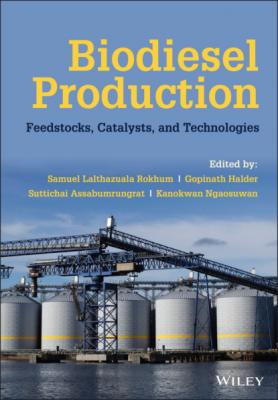ТОП просматриваемых книг сайта:
Biodiesel Production. Группа авторов
Читать онлайн.Название Biodiesel Production
Год выпуска 0
isbn 9781119771357
Автор произведения Группа авторов
Издательство John Wiley & Sons Limited
Table 2.2 Traditional catalyzed conversions using acids, bases, enzymes, or other catalysts.
Source: Modified from Ref. [2].
| Feedstock | Catalyst used | Reaction conditions | Yield/conversion (%) | References | ||||
|---|---|---|---|---|---|---|---|---|
| Reaction temperature (°C) | Reaction time (h) | Catalyst concentration (% w/w) | Alcohol:oil (ratio or wt%) | Agitation speed (rpm) | ||||
| Acid‐catalyzed conversion | ||||||||
| Castor oil | H2SO4 | 50 | 1 | 1 | 20 : 1 | 700 | 90.83 | [4] |
| Waste cooking oil | H2SO4 | 60 | 3 | 5 | 12 : 1 | 800 | 95.376 | [3] |
| Mahua oil | Sulfonated Delonix regia char | 50 | 1 | 4 | 6 : 1 | 1000 | 97.04 | [5] |
| Castor oil | Sulfonated MFL char | 60 | 1.5 | 7 | 70 | 950 | 92 | [16] |
| Base‐catalyzed conversion | ||||||||
| Waste cooking oil | KOH | 50 | 1.67 | 0.75 | 9 : 1 | — | 90 | [20] |
| Waste cooking oil | CaO | 75 | 1 | 5 | 9.8 : 1 | 450 | 96.6 | [21] |
| Waste cooking oil | CaO | 65 | 3 | 7.5 | 15 : 1 | 1200 | 90 | [22] |
| Waste cooking oil | Calcined egg shells | 65 | 5.5 | 3.5 | 22.5 : 1 | 600 | 91 | [23] |
| Enzyme‐catalyzed conversion | ||||||||
| Waste cooking oil | Lipase | 50 | 10 | 6 | 20 | — | 94 | [24] |
| Jatropha oil | Lipase | 40 | 8 | 0.5 | 4 : 1 | — | 71 | [25] |
| Other novel catalysts for conversion | ||||||||
| Waste cooking oil | Fe(II)‐doped anthill | 60 | 1.5 | 1.2 | 6 : 1 | — | 99.73 | [15] |
| Rubber seed oil | Fe(II)‐doped Delonix regia char | 40 | 15 | 5 | 3 : 1 | 500 | 96.31 | [26] |
| Two‐step catalyzed conversion | ||||||||
| Waste cooking oil | H2SO4 | 65 | 3 | 1 | 3 : 7 | 400 | 21.5 | [27] |
| NaOH | 50 | 3 | 1 | 3 : 7 | 400 | 90.6 | ||
| Karanja oil | Sulfonated Delonix regia char | 50 | 0.75 | 3 | 12 : 1 | 900 | 99.86 | [6] |
| KOH‐doped Delonix regia char | 60 | 1.5 | 4 | 6 : 1 | 700 | 99.39 | ||
2.5.1.3 Enzyme Catalysis
The wastewater generated from washing of fuels using acid or base catalysts is not pH neutral, and thus can hamper water bodies connected to the discharge stream if the generated effluent is left untreated before drainage. Enzymes can also be beneficial in

